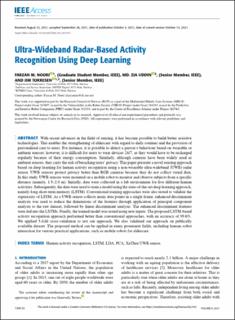| dc.contributor.author | Noori, Farzan Majeed | |
| dc.contributor.author | Uddin, Md Zia | |
| dc.contributor.author | Tørresen, Jim | |
| dc.date.accessioned | 2022-08-30T14:30:55Z | |
| dc.date.available | 2022-08-30T14:30:55Z | |
| dc.date.created | 2021-10-21T18:14:54Z | |
| dc.date.issued | 2021 | |
| dc.identifier.citation | IEEE Access. 2021, 9, 138132-138143. | en_US |
| dc.identifier.issn | 2169-3536 | |
| dc.identifier.uri | https://hdl.handle.net/11250/3014435 | |
| dc.description.abstract | With recent advances in the field of sensing, it has become possible to build better assistive technologies. This enables the strengthening of eldercare with regard to daily routines and the provision of personalised care to users. For instance, it is possible to detect a person’s behaviour based on wearable or ambient sensors; however, it is difficult for users to wear devices 24/7, as they would have to be recharged regularly because of their energy consumption. Similarly, although cameras have been widely used as ambient sensors, they carry the risk of breaching users’ privacy. This paper presents a novel sensing approach based on deep learning for human activity recognition using a non-wearable ultra-wideband (UWB) radar sensor. UWB sensors protect privacy better than RGB cameras because they do not collect visual data. In this study, UWB sensors were mounted on a mobile robot to monitor and observe subjects from a specific distance (namely, 1.5–2.0 m). Initially, data were collected in a lab environment for five different human activities. Subsequently, the data were used to train a model using the state-of-the-art deep learning approach, namely long short-term memory (LSTM). Conventional training approaches were also tested to validate the superiority of LSTM. As a UWB sensor collects many data points in a single frame, enhanced discriminant analysis was used to reduce the dimensions of the features through application of principal component analysis to the raw dataset, followed by linear discriminant analysis. The enhanced discriminant features were fed into the LSTMs. Finally, the trained model was tested using new inputs. The proposed LSTM-based activity recognition approach performed better than conventional approaches, with an accuracy of 99.6%. We applied 5-fold cross-validation to test our approach. We also validated our approach on publically available dataset. The proposed method can be applied in many prominent fields, including human–robot interaction for various practical applications, such as mobile robots for eldercare. | en_US |
| dc.language.iso | eng | en_US |
| dc.publisher | Institute of Electrical and Electronics Engineers (IEEE) | en_US |
| dc.rights | Navngivelse 4.0 Internasjonal | * |
| dc.rights.uri | http://creativecommons.org/licenses/by/4.0/deed.no | * |
| dc.title | Ultra-Wideband Radar-Based Activity Recognition Using Deep Learning | en_US |
| dc.type | Peer reviewed | en_US |
| dc.type | Journal article | en_US |
| dc.description.version | publishedVersion | en_US |
| dc.source.pagenumber | 138132-138143 | en_US |
| dc.source.volume | 9 | en_US |
| dc.source.journal | IEEE Access | en_US |
| dc.identifier.doi | 10.1109/ACCESS.2021.3117667 | |
| dc.identifier.cristin | 1947653 | |
| dc.relation.project | Norges forskningsråd: 312333 | en_US |
| dc.relation.project | Norges forskningsråd: 247697 | en_US |
| dc.relation.project | Norges forskningsråd: 288285 | en_US |
| dc.relation.project | Norges forskningsråd: 262762 | en_US |
| cristin.ispublished | true | |
| cristin.fulltext | original | |
| cristin.qualitycode | 1 | |

